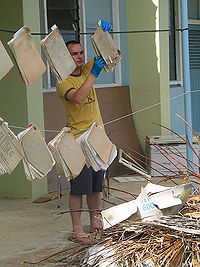Course:LIBR562/S2012/Group3/Niue
Niue (pronounced new’-ay [1]) became a territory of New Zealand in 1901, after a brief period of being a British Protectorate. Though Niue essentially gained independence in 1974, it remains in free association with New Zealand[2].
Niue has an estimated population of 1,200 people, with English as their official language, though Niuean is also spoken. The current literacy rate is 95%. [3]
Featured Library
The University of the South Pacific has a small campus library located on Niue that holds about 3000 volumes. Borrowing privileges are extended to current and former USP students and staff. Non-students are allowed to use the collection, but not to borrow items.[4]

Preservation Concerns
Niue, in addition to general preservation concerns present in all tropical climates, they are also vulnerable to experiencing disasters. Unfortunately, their most recent disaster plan does not have a risk assessment or profile for Niue.[5] Nonetheless, they do have plans and procedures in place for at least preparing and attempt to manage disasters.[6]
Legislation
Laws in Niue provide for both public libraries and standards for prison libraries. The Village Councils Act of 1967 endows the Councils with authority over numerous projects, including public libraries, under Section 27 1 & 2, sub-section 9.[7] The Councils are responsible for the “undertaking, provision, construction, maintenance, management and regulation of... [9] public halls, public libraries and community centres”.[8] The Act further mentions more specific proposals like adult education programs and cultural centers, as well as the possibility to give grants to associations involved in advancing this type of work.
The Niue Penal Manual 2006 establishes a prison library under Part 2, regarding the welfare of inmates.[9] Two brief paragraphs outline both the right of inmates to pursue an education and the responsibility of the prison to provide reading materials to inmates.
References
- ↑ Niue. Wikipedia: http://en.wikipedia.org/wiki/Niue. Retrieved June 2, 2012.
- ↑ Government of Niue. http://www.gov.nu/wb/pages/system-of-government-fakatokaaga-he-fakatufono.php. Retrieved May 28, 2012.
- ↑ Niue. (2012). CIA World Factbook. https://www.cia.gov/library/publications/the-world-factbook/geos/ne.html. Retrieved Mary 27, 2012.
- ↑ Campus and Center Directory. University of the South Pacific. http://www.usp.ac.fj/index.php?id=lib_centredir. Retrieved June 2, 2012.
- ↑ iue. 2010. Niue National Disaster Plan. Niue Government, A-4.
- ↑ iue. 2010. Niue National Disaster Plan. Niue Government, A5-A6.
- ↑ Village Councils Act, 1967. Niue Laws, Volume 3, Statutes N-Z. Government of Niue, 2006. http://www.gov.nu/wb/pages/legislation-matafakatufono/niue-laws.php Retrieved May 27, 2012.
- ↑ p. 1746. Village Councils Act, 1967. Niue Laws, Volume 3, Statutes N-Z. Government of Niue, 2006. http://www.gov.nu/wb/pages/legislation-matafakatufono/niue-laws.php Retrieved May 27, 2012.
- ↑ p. 348. Penal Manual, 2006. Niue Laws, Volume 4, Subsidiary Legislation. Government of Niue, 2006. http://www.gov.nu/wb/pages/legislation-matafakatufono/niue-laws.php Retrieved May 27, 2012.